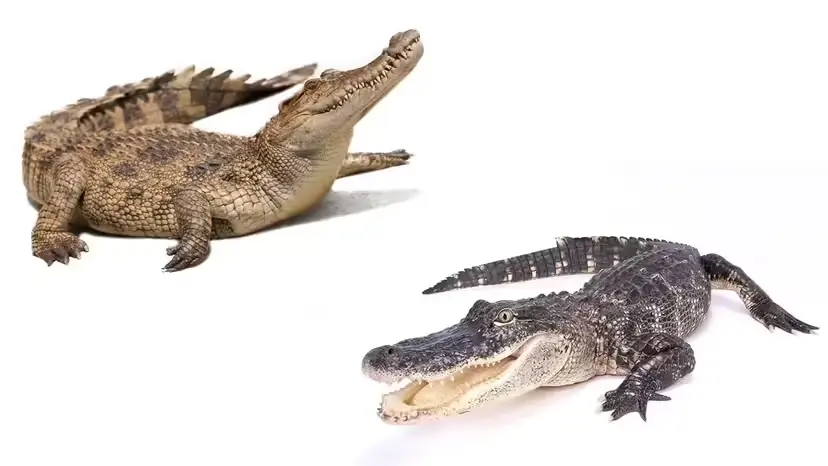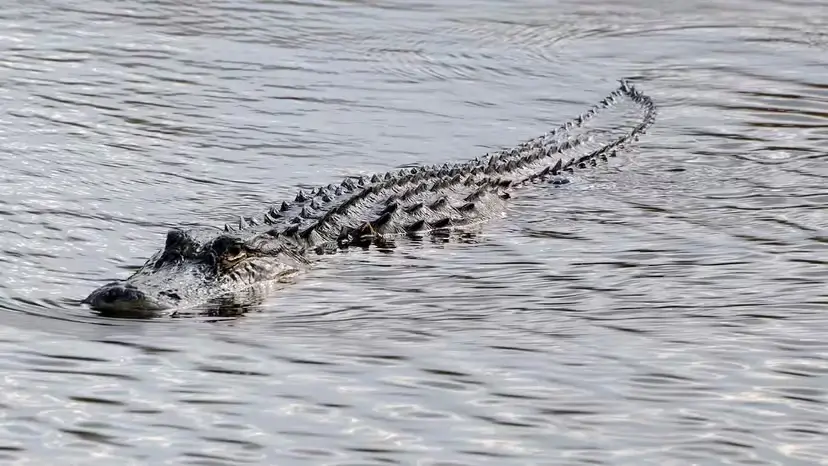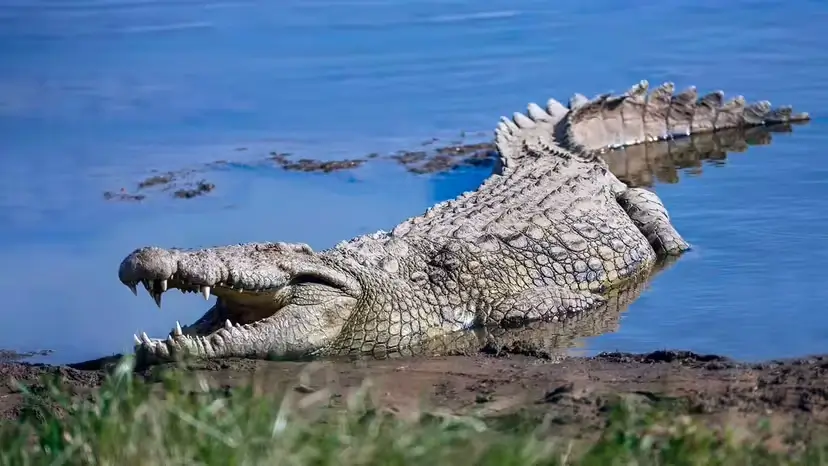At a glance they look alike—armored skin, colossal jaws, ancient vibes. But alligators and crocodiles split early on the crocodilian family tree and evolved for different waters, diets, and lifestyles. Once you know what to look for, you can ID them in seconds—and understand which one would rule a showdown (and why).

Snout shape
Alligators carry a broad, U-shaped snout designed for crunching turtles and hard-shelled prey. With the jaws closed, the upper jaw hides most lower teeth—that big fourth lower tooth tucks into a notch in the upper jaw.
Crocodiles wear a narrower, V-shaped snout. When the mouth shuts, teeth interlock and remain visible—especially that prominent fourth lower tooth.
Average size & power
Adult male American alligators typically top out around 11–13 ft (3.3–4.0 m), exceptional giants near 14–15 ft.
Large crocodiles—especially saltwater crocodiles and Nile crocodiles—can reach 18–20+ ft (5.5–6+ m) and outweigh gators. Crocodiles hold the crown for bite force among living animals.
Water preference
Alligators are primarily freshwater specialists (swamps, marshes, slow rivers).
Crocodiles tolerate brackish and saltwater thanks to efficient lingual salt glands that excrete excess salt. That’s why you often see crocs near estuaries and coastlines—and gators deeper inland.
Feet & fringe
Alligators have more fully webbed rear feet for powerful freshwater swimming.
Crocodiles tend to show separated toes and a jagged dermal fringe along the hind legs and tail.

Alligators (family Alligatoridae)
• American alligator (Alligator mississippiensis): Southeastern United States—Louisiana, Florida, Georgia, the Carolinas, east Texas—thriving in wetlands and cypress swamps. Once heavily poached, now a conservation success in many areas.
• Chinese alligator (Alligator sinensis): Critically endangered remnant populations in the lower Yangtze basin. Much smaller than its American cousin, with a shorter, upturned snout and heavy bony armor on the skull.
Crocodiles (family Crocodylidae)
Found across Africa, Asia, Australia, and the Americas. Notable heavyweights include:
• Saltwater crocodile (Crocodylus porosus): Indo-Pacific coasts and estuaries, the world’s largest living reptile.
• Nile crocodile (Crocodylus niloticus): Sub-Saharan Africa’s dominant freshwater apex predator.
• American crocodile (Crocodylus acutus): South Florida, Caribbean, Central and northern South America—keen on brackish habitats.
(Other species include Cuban, Morelet’s, Orinoco, Philippine, Siamese, West African, slender-snouted, dwarf, New Guinea, mugger, and Australia’s freshwater crocodile.)

Both are stealth hunters with pressure-sensing skin organs that detect ripples from prey. Both ambush at the water’s edge and can sprint in short bursts. But crocodiles, on average, skew more aggressive toward large animals—including us—especially in regions where they overlap with people.
When crocodiles seize prey, they often use a crushing bite, then a “death roll”—a violent, whole-body spin that tears flesh and dismembers. Alligators can roll too, but the behavior (and human risk) is most notorious in big croc species.
In a neutral matchup, the crocodile usually wins. Size, mass, jaw architecture, salt tolerance (for more varied hunting grounds), and a generally bolder disposition tilt the odds. A max-size saltwater or Nile crocodile out-ranges and out-weighs the largest recorded gators by a wide margin.
Risk tracks species and setting.
• In the United States, American alligators and American crocodiles seldom attack unprovoked; most incidents involve habituation to feeding or pets near the waterline.
• In Africa and parts of Asia/Oceania, Nile and saltwater crocodiles account for most fatal crocodilian attacks worldwide due to size, proximity, and behavioral ecology.
Practical safety: keep well back from the water’s edge, never feed crocodilians, leash pets, and treat “calm” basking animals as if they could close the distance faster than you think.
Caimans are New World crocodilians within Alligatoridae—smaller on average than gators and crocs, occupying Central and South American wetlands and rivers. Species include the spectacled caiman, yacare caiman, broad-snouted caiman, black caiman (the giant of the group), and the two dwarf caimans. They share the alligator-style broad snout but vary widely in size and habitat.
See a broad, rounded snout and mostly hidden lower teeth when the mouth is shut? Likely an alligator in freshwater.
See a narrow, pointed snout, visible interlocking teeth, and brackish/coastal habitat? Likely a crocodile.
Beyond trivia, the differences shape how we conserve and coexist with these ancient reptiles. Habitat preference informs where people are at risk, salt tolerance drives range expansion, and size/behavior guide management—from signage and zoning to rescue and relocation. Knowing which animal you’re looking at helps you make safer, smarter choices around their waters—and appreciate just how finely tuned each is to its world.
animal tags:
We created this article in conjunction with AI technology, then made sure it was fact-checked and edited by a Animals Top editor.